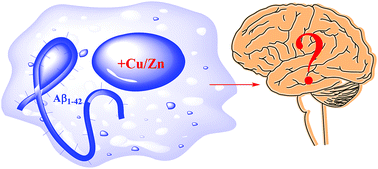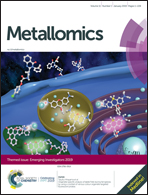Cu and Zn interactions with Aβ peptides: consequence of coordination on aggregation and formation of neurotoxic soluble Aβ oligomers
Abstract
The coordination chemistry of transition metal ions (Fe, Cu, Zn) with the amyloid-β (Aβ) peptides has attracted a lot of attention in recent years due to its repercussions in Alzheimer's disease (AD). Aβ peptide undergoes self-aggregation to form amyloid plaques and soluble oligomers, which are believed to play a central role in AD pathology. Metal ions and Aβ-metal adducts can generate toxic radical species capable of modifying biomolecules, ultimately causing death of the neuronal cells. The impact of these metal ions on Aβ aggregation and neurotoxic species formation is still not well understood. A large number of reports indicate that transition metal ions such as Cu and Zn have significant effects on Aβ peptide aggregation and stabilization of neurotoxic soluble Aβ aggregates; some of these reports are contradictory too. A review on the effects of Cu and Zn metal ions on Aβ peptide aggregation due to their coordination with these peptides is presented herein. The review includes brief discussions with regards to the levels of Cu and Zn in an AD affected brain, structures of Aβ peptides, and the coordination of Aβ peptides with Cu and Zn. In the current scenario, a consensus appears to be emerging regarding the coordination mode and the effect of metal ions (especially Cu and Zn) on the aggregation of Aβ peptides. Towards the end, a short discussion on current research trends in the field of bifunctional metal chelators for tackling the metal effect on Aβ aggregation and toxicity has also been presented. It is expected that this review would aid in gaining a better understanding of the current status of various aspects of AD from an inorganic chemistry perspective.

- This article is part of the themed collections: Recent Review Articles and Metallomics Emerging Investigators


 Please wait while we load your content...
Please wait while we load your content...